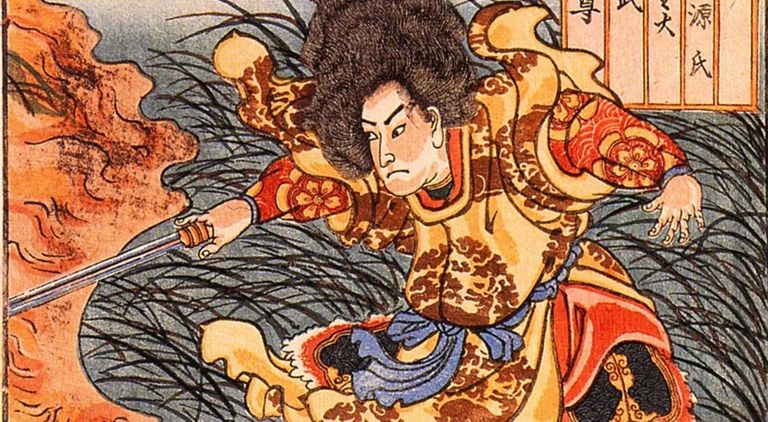D Class
大国主神 (Ōkuninushi-no-Kami)
Central among the earthly deities (kunitsukami), Ōkuninushi is revered as the sovereign of the land. As the deity responsible for the creation of Japan, he features prominently in myths involving the white rabbit of Inaba, visits to the land of the roots, and other legends chronicled in both the Kojiki and Nihon Shoki. Ōkuninushi is enshrined at Izumo Taisha and Ōminasudera Shrine, underscoring his importance as a nation-building figure.
建御名方神 (Takeminakata-no-Kami / Takeminakata-no-Kami)
Featured in the myth of pacifying the central region of Japan, this deity was dispatched from Takamagahara along with the thunder god Takeminakata to demand the submission of Ōkuninushi. In the ensuing contest of strength, Takeminakata engaged in a dramatic hand-to-hand battle that ended with his retreat—an act that ultimately led him to promise allegiance to the divine mandate. His conflict with Takeminakata-no-Kami is remembered as a defining moment in the divine ordering of Japan.
天稚彦 (Ame-no-Wakahiko)
Also known as Ama-no-Wakahiko, this deity was chosen to marry Ōkuninushi’s daughter. However, ambition led him to attempt to seize control of Ashihara no Nakatsukuni (the earthly realm). After eight years of defiance, Amaterasu and Takamimusubi dispatched a messenger—first a pheasant, then Ame-no-Sagume—whose ominous counsel convinced him to heed the call of heaven. In a tragic twist, the arrow (forged by Takamimusubi and called Ame-no-Hahiyari or Ama-no-Makago Yumi) struck him down, sealing his fate.
E Class
天穂日命 (Ame-no-Hohi-no-Mikoto)
Tasked with the subjugation of Ashihara no Nakatsukuni, Ame-no-Hohi ultimately failed in his divine mission. Consequently, he became one of Ōkuninushi’s retainers. Regarded as the progenitor of the Izumo and Haji clans, his story weaves together themes of both divine authority and human endeavor.
F Class
神武天皇 (Jinmu Tennō)
The legendary first emperor of Japan, Jinmu Tennō is said to be a fifth-generation descendant of Amaterasu. According to ancient chronicles like the Nihon Shoki and the Kojiki, he embarked on an eastward conquest—vanquishing local chieftains in the Nara Basin—and established his capital at Kashihara in present-day Nara Prefecture, thereby founding Japan.
倭建命 (Yamato Takeru-no-Mikoto)
Known in the Nihon Shoki as Yamato Takeru and in the Kojiki as Yamato Takeru, this legendary hero is famed for his campaigns against rebellious deities and unruly tribes. As the son of Emperor Keikō and the father of Emperor Chūai, his daring exploits—such as the subjugation of the bear clans—cement his status as one of Japan’s most celebrated warriors.
海幸彦 (Umisachihiko)
Also known as Hiteru-no-Mikoto in the Kojiki and Hiraka-no-Mikoto in the Nihon Shoki, this deity’s legend is linked with the pacification of the southern regions of Japan. His narrative is thought to have inspired various local myths, including those surrounding the origins of the Hayato people and even elements of the legend of Urashima Tarō.
G Class
熊襲建兄弟 (Kumaso Takeru Kyōdai)
This duo of powerful chieftains from western Japan once posed a serious threat to Yamato Takeru. In the ancient records, they are depicted either as two brothers—Kumaso Tatekeru and Kumaso Ototakeru—or, in some texts, as a single formidable leader. Ultimately, their power was eclipsed by Yamato Takeru’s might, and they are remembered as fierce but ultimately defeated adversaries.
H Class
野見宿禰 (Nomi Sukune)
A descendant in the 14th generation from Ame-no-Hohi, Nomi Sukune is celebrated as the progenitor of sumo wrestlers. Summoned from Izumo by Emperor Sujin (or Emperor Suinin in some accounts) to settle a sumo bout with Taimase-hayai, he triumphed by breaking his opponent’s waist bone. As a reward, he was granted territory in the Yamato region—an area that includes present-day Taimasa in Nara Prefecture. His legacy is commemorated at several shrines across Japan, such as Nomi Shrine in Toyota (Aichi Prefecture) and Katano Shrine in Hirakata (Osaka Prefecture).
I Class
当麻蹴速 (Taimase-Hayahaya)
Known for his boastful claim that none could match his strength, Taimase-Hayahaya met his downfall at the hands of Nomi Sukune. In a dramatic contest, Nomi Sukune shattered Taimase’s bones, ultimately claiming victory and seizing his lands. This episode marks one of the legendary contests of strength in Japanese mythology.
J Class
久延毘古 (Kuebiko)
Appearing in the Kojiki, Kuebiko is a deity who, despite being unable to walk, is famed for his vast knowledge of all things under heaven. Often identified with scarecrows or personifications of the fields, he is revered as the god of agriculture, learning, and wisdom. Shrines such as Kuhebi-no-Kami Shrine in Noto (Ishikawa Prefecture) and the subsidiary shrines of Ōminasudera in Sakurai (Nara Prefecture) honor his legacy.
This ranking, combining various myths and legends, provides a glimpse into the rich tapestry of Japanese mythology—where creation, valor, tragedy, and wisdom intertwine in the stories of gods both mighty and mysterious.
Conclusion
Japanese mythology is a magnificent tapestry woven from epic tales of creation, heroic battles, and divine intrigue. From the primordial gods who birthed the cosmos to the legendary heroes who forged Japan’s destiny, these deities embody the awe-inspiring power and mystery of ancient tradition. Their stories, steeped in symbolism and cultural significance, not only illuminate the values and aspirations of a bygone era but continue to inspire modern thought and art. As you explore these timeless legends, may you find yourself captivated by the enduring legacy of Japan’s mythical past and the extraordinary spirit that has shaped its history.


Comments